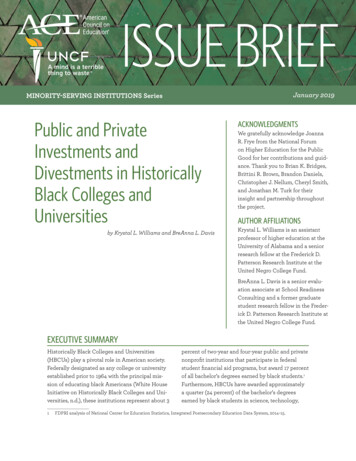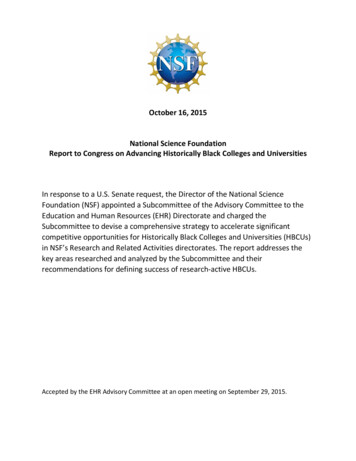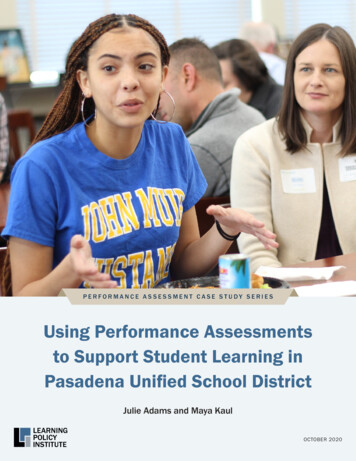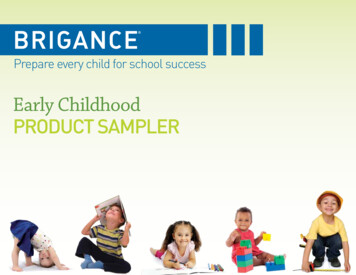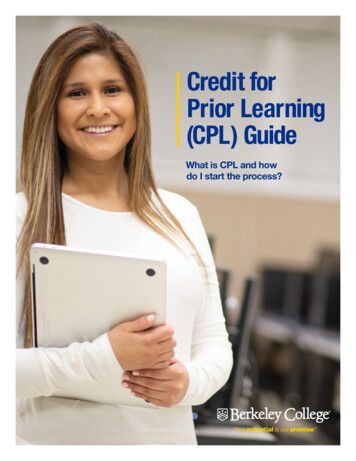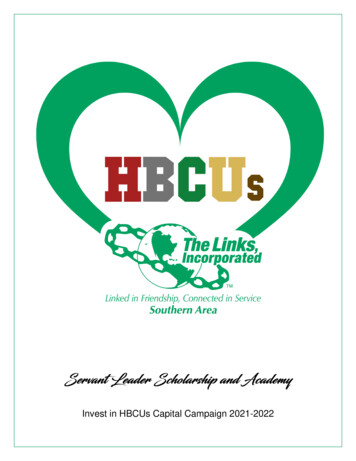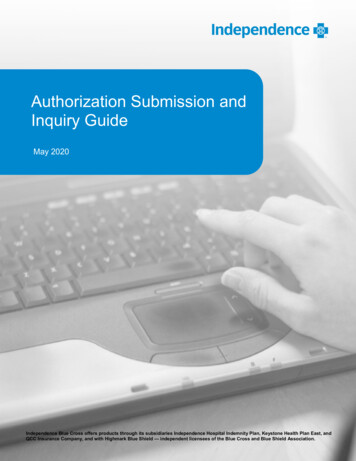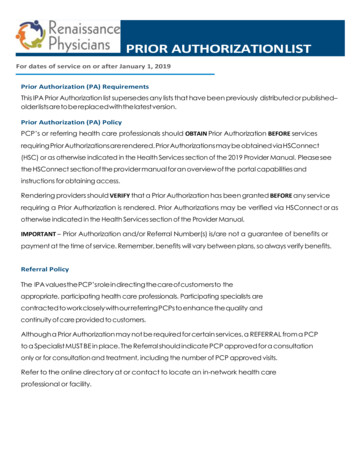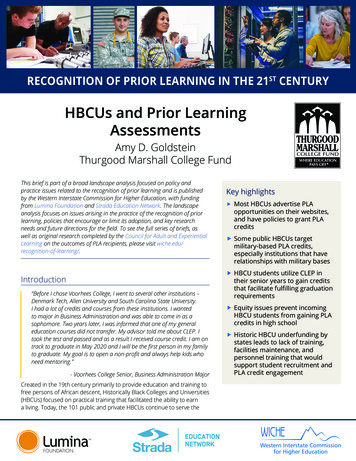
Transcription
RECOGNITION OF PRIOR LEARNING IN THE 21ST CENTURYHBCUs and Prior LearningAssessmentsAmy D. GoldsteinThurgood Marshall College FundThis brief is part of a broad landscape analysis focused on policy andpractice issues related to the recognition of prior learning and is publishedby the Western Interstate Commission for Higher Education, with fundingfrom Lumina Foundation and Strada Education Network. The landscapeanalysis focuses on issues arising in the practice of the recognition of priorlearning, policies that encourage or limit its adoption, and key researchneeds and future directions for the field. To see the full series of briefs, aswell as original research completed by the Council for Adult and ExperientialLearning on the outcomes of PLA recipients, please visit Before I chose Voorhees College, I went to several other institutions –Denmark Tech, Allen University and South Carolina State University.I had a lot of credits and courses from these institutions. I wantedto major in Business Administration and was able to come in as asophomore. Two years later, I was informed that one of my generaleducation courses did not transfer. My advisor told me about CLEP. Itook the test and passed and as a result I received course credit. I am ontrack to graduate in May 2020 and I will be the first person in my familyto graduate. My goal is to open a non-profit and always help kids whoneed mentoring.”- Voorhees College Senior, Business Administration MajorCreated in the 19th century primarily to provide education and training tofree persons of African descent, Historically Black Colleges and Universities(HBCUs) focused on practical training that facilitated the ability to earna living. Today, the 101 public and private HBCUs continue to serve theKey highlights Most HBCUs advertise PLAopportunities on their websites,and have policies to grant PLAcredits Some public HBCUs targetmilitary-based PLA credits,especially institutions that haverelationships with military bases HBCU students utilize CLEP intheir senior years to gain creditsthat facilitate fulfilling graduationrequirements Equity issues prevent incomingHBCU students from gaining PLAcredits in high school Historic HBCU underfunding bystates leads to lack of training,facilities maintenance, andpersonnel training that wouldsupport student recruitment andPLA credit engagement
African American community, with 85 percent of HBCUstudents being African American. HBCUs also continueto foster economic opportunity through educationalattainment for low-income students.One way in which HBCUs might improve educationoutcomes for their students is through thedevelopment and implementation of prior learningassessment (PLA) policies and practices. PLA is theprocess for evaluating and awarding credit for collegelevel learning that has been acquired outside of theclassroom through work and life experience. It haslong been known that PLA has a positive correlationwith student persistence in higher education,1 highergraduation rates,2 and shorter times to degreeattainment for non-traditional students.3Yet, to date, there has been no research done onthe types of PLA offered at HBCUs and studentoutcomes related to PLA. This brief fills this gap byexploring the ways in which HBCUs acknowledge andaward postsecondary credit to students like the oneattending Voorhees College for college-level learningthat took place outside of the institution as a wayto improve student outcomes. To do so, ThurgoodMarshall College Fund (TMCF) undertook researchthat reviewed information publicly available regardingPLA policies and information on HBCU websites.The research also engaged in a more in-depth casestudy analysis of four targeted HBCUs, each of whichrepresents a distinct type of institution. This briefconcludes with recommendations for policy andpractice with regard to HBCUs and other institutionsfacing similar resource constraints.While PLA is often discussed as a strategy to helpreturning adult students who have work experience,the methods most commonly used among HBCUs(pre-college test-based assessments, military-basedcredit, or knowledge/experience-based assessment)are not available to all students, particularly to thosewho are older. Military credits are available only toactive military service members and veterans, andcredit for AP/IB is generally available only to highschool students. TMCF was guided in its PLA definitionused throughout this brief by the HBCUs themselves,so this brief highlights only certain methods. Otherbriefs in this series generally focus less on types ofPLA credit earned through high school programs andmore on those aimed at adult learners. However, theinequitable access to AP and IB courses (and resultantcredit) is a central issue for students at HBCUs (and forunderrepresented students in general) and deservesfurther study and focus in discussions about PLA.2What is Prior Learning AssessmentMany students – as well as potential students – haveacquired a great deal of college-level knowledge andskills through their day-to-day lives outside of academia:from work experience, on-the-job training, formalcorporate training, military training, volunteer work,self-study, and myriad other extra-institutional learningopportunities available through low-cost or no-costonline sources.The process for recognizing and awarding credit forcollege-level learning acquired outside of the classroomis often referred to as Prior Learning Assessment (PLA).There are several ways students can demonstrate thislearning and earn credit for it in college. The variouspartners involved in creating this series of briefs areexamining different types of PLA and using the followinggeneral descriptions of the different methods. Standardized examination: Students canearn credit by successfully completing examssuch as Advanced Placement (AP), CollegeLevel Examination Program (CLEP), InternationalBaccalaureate (IB), Excelsior exams (UExcel),DANTES Subject Standardized Tests (DSST), andothers. Faculty-developed challenge exam: Studentscan earn credit for a specific course by taking acomprehensive examination developed by campusfaculty. Portfolio-based and other individualizedassessment: Students can earn credit by preparinga portfolio and/or demonstration of their learningfrom a variety of experiences and non-creditactivities. Faculty then evaluate the student’sportfolio and award credit as appropriate. Evaluation of non-college programs: Studentscan earn credit based on recommendationsprovided by the National College CreditRecommendation Service (NCCRS) and theAmerican Council on Education (ACE) that conductevaluations of training offered by employers or themilitary. Institutions also conduct their own reviewof programs, including coordinating with workforcedevelopment agencies and other training providersto develop crosswalks that map between externaltraining/credentials and existing degree programs.RECOGNITION OF PRIOR LEARNING IN THE 21ST CENTURY
Background on HBCUsHBCUs are defined as institutions of higher education that were established prior to 1964, whose principal missionwas, and is, the education of Black Americans. HBCUs primarily serve low-income students and first-generation collegestudents who come from underserved communities, whether urban or rural. HBCUs were founded to educate theleast-resourced individuals, free-born people of African descent (for instance, Cheyney University in Pennsylvania),and former slaves. Cheyney University in Pennsylvania, America’s first HBCU, was founded in 1837 as the “Institute forColored Youth.” In 1851, the Miner Normal School – today’s University of the District of Columbia – was established as aschool for African American women. The Ashmun Institute was founded in 1854 in Pennsylvania (Lincoln University), andin 1856, Wilberforce University was founded by the African Methodist Episcopal Church in Wilberforce, Ohio – the firstHBCU owned and operated by African Americans. LeMoyne-Owen College was opened in Memphis, Tennessee in 1862.Predominantly Black Institutions of Higher Education (PBIs) were founded after 1964. PBIs have at least 1,000undergraduate students, of which not less than 50 percent are low-income or first-generation to attend college, andwhose student body is composed of at least 40 percent Black students, and of which not less than 50 percent are ina baccalaureate program. Today, there are 101 HBCUs and PBIs (called HBCUs for the remainder of the chapter). Ofthese institutions, 89 are four-year public or private institutions, and 12 are two-year institutions. Two of the four-yearinstitutions are private HBCUs that are publicly supported: Howard University and Tuskegee University. There are 47publicly supported HBCUs and 34 private HBCUs.HBCUs serve a specific student population – very low-resourced individuals – to this day. Overall, 85 percent of HBCUstudents are African American, with 8 percent White, 4 percent Hispanic, 2 percent Asian/Pacific Islander/NativeHawaiian, and 2 percent two or more races. Over 80 percent of the students attending HBCUs attend publicly supportedinstitutions, and of those, the overwhelming majority of students are low-income (Pell Grant eligible). For first-time, firstyear HBCU students, 73 percent are Pell Grant eligible, but that number decreases to 64 percent for all undergraduatestudents – indicating that students stop-out of school between the time they enter and the second year. By comparison,private HBCUs match the 36 percent national average of first-time, first-year students eligible for Pell Grants as well asfor all undergraduates. Each of these schools is a legacy brand with deep meaning and garner respect in the AfricanAmerican community.HBCUs have an outsized significant impact on their students. For example, HBCUs have educated: 80 percent of Black judges 50 percent of Black lawyers 40 percent of Black Congress members 12.5 percent of CEOs over 50 percent of Black teachers over 80 percent of all Black doctors and dentists 40 percent of Black engineers and 30 percent of Black doctoral recipients in STEM (science, technology, engineering, mathematics) fields.4HBCUs outperform Predominantly White Institutions (PWIs) at preparing Black students for future careers andleadership, especially in STEM. HBCUs continue to lead in awarding African American student undergraduate degreesin STEM with many of those students going on to earn doctorate degrees.5 Of the top 25 undergraduate institutionswhose graduates went on to complete STEM doctorates, 12 HBCUs outproduced prestigious institutions by 64 percent(Harvard, Yale, Brown, Michigan, UC Berkeley, MIT, Cornell, UVA, UNC Chapel Hill, etc.).6For HBCUs, student outcomes include degree attainment (graduation), but also entry into economically sustainablecareers that can lift them into the middle class. A recent study reveals that nearly 70 percent of HBCU graduates enterthe middle class or higher and that there is less downward mobility for African American students graduating fromHBCUs than for those attending PWIs.7 As stated by the Gallup-USA Funds Minority College Graduates Report, “Despitetheir well-publicized challenges, in many areas, [HBCUs] are successfully providing Black graduates with a better collegeexperience than they would get at non-HBCUs.”8HBCUs and PRIOR LEARNING ASSESSMENTS3
Public Information on Credit for PriorLearning at HBCUsAs part of this current study, TMCF first engagedin a review of all publicly available information onHBCU websites to understand how HBCUs utilizePLA. TMCF found that most HBCUs have a policyof accepting some form of PLA, whether AdvancedPlacement (AP), International Baccalaureate (IB),College Level Examination Program (CLEP), militarycredit, or placement tests. HBCU website content canbe broken down into several buckets related to priorlearning: references to recommendations offeredby the Council for Adult and Experiential Learning(CAEL); references to alternative credit providers; andmilitary offerings and recommendations offered bythe American Council on Education (ACE).Several HBCUs partner with CAEL to offer “LearningPortfolio Review for Credit,” a method of PLA thatinvolves a detailed evaluation of a portfolio that thestudent develops to document the learning theyreceived from their work and/or life experience.Prairie View A&M University (PVAMU) in PrairieView, Texas features the Experiential LearningPortfolio (ELP) review, which utilizes the LearningCounts online portfolio assessment offered byCAEL. Through a course, students create a portfoliothat is evaluated for demonstrated learning, andLearning Counts makes a recommendation for creditequivalency.9 Six HBCUs in addition to PVAMU arelisted on the CAEL website as member institutionsof ELP: Alabama A&M University; Albany StateUniversity; Fort Valley State University; SavannahState University (via University System of Georgia);Jarvis Christian College (private); and Medgar EversCollege (part of the City University of New Yorksystem).Fayetteville State University’s (FSU) website says thatit recognizes certain “Alternative Credit Courses,”which are offered by non-profit organizationsand for-profit companies – such as Pearson,Saylor, Ed4Credit, Straighterline, or others.10 FSU’sAlternative Credit Course program began withits participation in the Alternative Credit Project,a national program of the American Council onEducation (ACE), which allowed students to earn upto 64 credits through 104 online and on-demandcourses offered by non-profit organizations andfor-profit companies. The Alternative Credit Projectended on March 31, 2018, but FSU continues torecognize this pathway to credit accumulation forits students, with prior approval from the university.4FSU was the only HBCU that participated in theAlternative Credit Program. An additional six Blackcolleges provide credit utilizing ACE’s portfolioevaluation, which mirrors PVAMU’s program:Chicago State University, Coppin State University,Jackson State University, Lincoln University inMissouri, Morgan State University, and Virginia StateUniversity.The majority of HBCUs (58 percent), and bothnational organizations that represent HBCUs, aremembers of ACE. However, only 12 schools utilizeACE for PLA evaluation through the ACE Creditfor Prior Learning Network. This network includesmore than 400 accredited colleges and universities“who have articulated policies for accepting priorlearning for credit.”11 Almost all HBCUs accept creditfor military training and/or military occupations,and most identify ACE on their websites as onepathway through which veterans can secure creditfor their military training. Nevertheless, the numberof credits varies by institution. North CarolinaCentral University’s (NCCU’s) website provides anexample: “Veterans, active duty service members,and members of the National Guard and ReserveComponents may receive a total of four creditsfor two courses (basic health and fitness) andthree credit hours for speech upon completion ofcertain military courses approved by the student’sappropriate academic dean.12 In addition, up to 12semester hours for military science electives may beawarded based on the number of years on activeduty.13 NCCU will accept up to 30 semester hoursof ACE-recommended military credit as transferwork toward a baccalaureate degree.14 Credit will beawarded as general elective credit or departmentelective credit. Credit for military service experiencesalso may be acquired through standardizedexaminations. Furthermore, NCCU goes on to say,“documented experience that falls outside of the ACErecommendations and/or transfer credit policies ofthe University will only be considered on a case-bycase basis through a Transfer Credit Appeal.”15Additionally, NCCU has its own Office of VeteransAffairs to support a transition from the militaryto college for veterans, active service and reservemembers, and military dependents. This supportincludes U.S. Department of Veterans Affairs (VA)Educational Benefits and additional support toensure academic success and progression towardgraduation. According to the College Factual Website,the VA reports that there are 394 NCCU studentsRECOGNITION OF PRIOR LEARNING IN THE 21ST CENTURY
who receive the post-9/11 GI Bill funding.16 This doesnot include students who are active military.About 25 percent of Fayetteville State’s studentsare active military, reservists, veterans, or militarydependents.17 Indeed, the institution has two centerson military bases – at Fort Bragg and at SeymourJohnson Air Force Base. In addition, FSU has aStudent Veterans’ Center to support the transitionfrom military life to college, as well as to help secureVA benefits and offer other support. Several otherHBCUs have dedicated centers or offices to supportveterans, active military, reservists, and militarydependents. One FSU junior majoring in criminaljustice stated:TMCF called each school, and the information thatTMCF received from the schools was that studentsprimarily utilize CLEP in their final year of school, toensure that they have fulfilled all of their graduationrequirements. Students generally utilize this processafter discovering missing classes or requirementsduring the advising process.Over the course of this research, TMCF heard fromthree students attending HBCUs who relied onCLEP (which they refer to as placement exams) intheir final year of school to support their graduationefforts.22 One of the student statements can befound on page one of this brief; the other two arebelow:“I served in the United States Army for over 15 yearsand when my military career ended, I decided that Iwanted to pursue a career in law enforcement. I feltthat it was a great opportunity to get my bachelor’sdegree and make a better life for my children. Mylast station was Fort Bragg and Fayetteville StateUniversity had a center on post. I talked with theadmissions people and submitted my applicationand was accepted. They did an audit on my militaryexperience and I received hours towards my degree.My brother attended Virginia State University andhe and I will be the only two people in our family tograduate from college. Fayetteville State is a greatplace, they understand their military students andmake sure we are informed.”“I have worked since the beginning of my collegecareer at Langston University. Managing classesand work is hard at times but I am a junior now.I took a summer course at another institution butrealized later that it couldn’t transfer. Luckily myadvisor and major professor told me about takinga placement test. I passed the test and was able tokeep my status as a junior. I am set to graduatein 2020 and I owe so much to Langston and theteachers who take the time with students.”- Langston University Junior,Liberal Education Major“Majoring in music requires a lot of vocal classes incollege. I enrolled at Shaw University after attendinga performing arts high school up North. When I wasset to graduate, I realized I needed an additionalcourse. My advisor and professor gave me theopportunity to take a placement test and graduateon time. My family was so happy. Shaw put forth areal effort to ensure that I graduated on time.”While this information demonstrates that HBCUsoffer some forms of PLA through official, definedpolicies, it is not clear how students make use ofthese offerings, or even how aware current orpotential students are about PLA. Moreover, thewebsites and undergirding policies do not revealthe rationale behind the institutions’ decision tooffer what they do. In order to address questionssuch as these, TMCF conducted case studies at fourrepresentative institutions.Prior Learning at Four RepresentativeHBCUsFor the case study analysis, TMCF reached out tofour HBCUs: Edward Waters College, FayettevilleState University, North Carolina Central University,and Voorhees College. These institutions representdifferent aspects of HBCUs such as sector, control,size, and location (see Table 1 on page 6).HBCUs and PRIOR LEARNING ASSESSMENTS- Shaw University Alumnus, MusicThese student testimonials point to a few features ofthe HBCU environment and student experience thatare instructive:zFirst is the usage of CLEP to completerequirements and graduate.zSecond is attending multiple institutions – eitherover the summer or in a progression from a twoyear to a four-year college, or multiple four-yearcolleges.5
Table 1: Demographics and Characteristics of Case Study InstitutionsSchool, LocationEdward WatersCollege,18Jacksonville, FLFayetteville StateUniversity,19Fayetteville, NCNorth CarolinaCentralUniversity,20Durham, NCVoorheesCollege,21Denmark, SCCampus SettingLarge cityMidsize cityLarge cityRural townControlPrivate not-forprofitPublicPublicPrivate not-forprofitOtherUndergraduateonlyServes alarge militarycommunityOne of thelargest publicstate HBCUsUndergraduateonlyUndergraduate Size in fall20182,906 total5,473 total6,434 total491 totalFull-time undergraduatesin fall 2018 (%)32%74%83%98%Percent of all studentsenrolled in 2018 whoidentified as Black60%58%75%96%Graduation Rate of 2012cohort (within 150% ofnormal time to programcompletion)20%35%46%43%Financial Aid in 2017-2018(Pell recipients; first-time,full-time students)88%76%77%84%4 first year(FY) studentsreceived CLEP188 FY studentsreceived CLEP 1,137 studentsenrolledreceived CLEP/CMT/ACE/DSST39 FY studentsreceived CLEP;177 enrolledstudentsreceived PLA8 FY studentsreceived CLEP;22 enrolledstudentsreceived PLANumber of PLA recipientszThird is commitment to persistence andgraduation, which is exemplified by summercoursework.zFourth is student unfamiliarity with themechanisms to attain prior learning credits,which is linked to equity issues.zFinally, the key catalyst for each student was theadvice of a professor and advisor who was morefamiliar with the mechanisms for achieving creditfor prior learning.At HBCUs, one of the more attractive features forAfrican American students is having professors6who are accessible, and whose life journeys mirrorthe students’. Advising students from a position ofcultural, social, and professional experience is criticalto student success.TMCF’s research revealed a dissonance betweenHBCU policy on PLA acceptance and the actualutilization by students. An analysis of all HBCUwebsites indicates that most HBCUs offer someforms of PLA through official, defined policies. Forexample, HBCU websites include references torecommendations offered by CAEL, referencesto alternative credit providers, military offeringsand recommendations offered ACE, and AP andRECOGNITION OF PRIOR LEARNING IN THE 21ST CENTURY
IB programs in high school. Interestingly though,when TMCF conducted interviews at four HBCUsto learn how students utilize PLA, these methodswere not mentioned, but rather another: studentsmost often used CLEP in their final year of schoolin order to get the remaining credits needed tograduate. The interviews suggest that academicadvisors are the ones to make this recommendationto students. Another brief in this series, Advisingand Prior Learning Assessment for Degree Completion,suggests that “institutional philosophy about PLAmay impact the robustness of advising-related policyand support systems for students.”23 TMCF suggeststhat a larger qualitative study be conducted acrossas many HBCUs as possible to better understandwhat PLA policies and programs are in place andhow students learn about and utilize these PLAopportunities.Prior Learning Assessment, HBCUs,and EquityWhile the numbers of students earning credit forPLA tend to be low at most HBCUs, the reasonsfor this underutilization go far beyond the HBCUsthemselves. This can be attributed to two underlyingreasons: lack of access to AP/IB in secondaryeducation among the population that the majority ofHBCUs serve, and institutional barriers such as lackof funding.When asked if any students earned credit throughAP/IB, the anecdotal response from each of the fourrepresentative HBCUs was that the students theseschools serve do not have access to these type ofcourses, and those who do have such access attendeither the flagship HBCUs (Spelman, Morehouse,Hampton), flagship state schools (University ofGeorgia, UNC-Chapel Hill), or elite schools (Harvard,Yale, etc.). Indeed, this response is in alignmentwith the results of research conducted by TMCF’sCenter for Advancing Opportunity, revealing thatonly 28 percent of fragile (low-income, underserved)community members believe that there is equalaccess to a college education, even though 87percent of Black fragile community members believethat a college education is an important pathway toeconomic success.24 These findings suggest a lackof access to sufficient college preparatory programsin low-income and underserved communities. Thefindings from the Center for Advanced Opportunityresearch study also suggest a mindset that highereducation is not attainable for these communityHBCUs and PRIOR LEARNING ASSESSMENTSmembers due to lack of services.Specifically, lack of access to AP and IB coursesis endemic for low-income African Americancommunities, and it highlights one of the PLA equityissues for HBCUs and the communities they serve.While African Americans make up approximately15 percent of all high school students, they have alower graduation rate than other groups (78 percentgraduation rate for African American students versus91 percent for Asian/Pacific Islander; 89 percent forWhite; and 80 percent for Hispanic),25 make up only8.8 percent of AP exam takers in 2018, according tothe College Board, and only 4.3 percent of studentsscoring a three or higher on those exams.26 As forlow-income students, the College Board reports thatit has doubled the number of these students takingAP exams in the past 10 years, from 16.5 percent in2008 to 30.8 percent in 2018.27 Yet it is clear that thisincrease is not made up of African American lowincome students.A Pipeline of Equity IssuesAlthough outside the scope of this brief, it is importantto recognize the structural racism and inequities acrossthe education continuum that contribute to inequitableaccess to PLA for Black students. Just some of the factorsinclude: Unequal access to early childhood education. Forexample, only 4 percent of 3- and 4- year-olds instate-funded high-quality early childhood educationprograms are Black, in a study of 26 states.28 Unequal student discipline for the same behavior(i.e. warnings versus suspensions). For example,Black students are three times as likely to be suspended or expelled compared to white students.29 Unequal treatment in student advising and supportof gifted students.30 Access to fewer high-quality, experiencedteachers. For example, teachers at public schoolswith majority Black and Latino populations aremore likely to have two years or less of teachingexperience compared to teachers at predominatelywhite schools in the same school district.31 Underfunding of K-12 schools that are predominantly Black. For example, school districts that servepredominately students of color receive roughly2,000 dollars less per student than school districtsthat serve predominately white populations.32 Educator racial bias leads to these greater7
disparities in discipline and test scores.33 Lack of training to reduce educator bias.34According to the College Board, in each graduatingclass, nationally only 40 percent of students whodemonstrate high potential for Advanced Placementsuccess are able to take an AP class – either becausetheir school does not offer AP classes or becausethey were unaware of their potential.35 Only threein 10 African American students demonstrating thepotential to succeed in AP science took a course in2013.36 Several factors contribute to these statistics,including student self-perception. Still, in high-needsurban or rural schools, a key reason for not offeringAP courses is a lack of trained teachers to deliver theadvanced courses. Another reason is that studentsdo not receive adequate instruction in scienceor mathematics courses prior to reaching highschool, so that those with the intellectual potentialto succeed do not have a base of knowledge thatwill allow them to succeed in advanced classes. Asthese students represent the primary pipeline forHBCUs, the issue of equity and PLA credit earnedthrough AP/IB courses is really an issue of precollege preparation – which begins in middle school,although school funding and the distribution oftrained teachers are also important considerations.Finally, lack of access to a PLA pipeline leaves AfricanAmerican students unfamiliar with the concept ofcredit for prior learning. Hispanic students oftenare advised to take some type of assessment toreceive credit for their Spanish language skills – andthis opens up the concept of PLA for them – noparallel pathway exists for African American or nonHispanic low-income students. Often data aboutAfrican American students are grouped togetherwith other ethnic and racial minorities, but thispoint highlights the fact that there are very differentexperiences for African American students than forHispanic students – even of similar socioeconomicstatus. Concurrent research conducted by theCouncil for Adult and Experiential Learning and theWestern Interstate Commission for Higher Educationunderscores this disparity.37Students who score a three or higher on an AP examare more likely to have higher GPAs, high schoolgraduation rates, and are more likely to graduatefrom college in four years and enter the workforce.38Not only does lack of access to AP courses lead toincreased expenses for additional years of college –which for HBCU students often translates to greater8debt levels – but it also results in lost income. “Failureto promptly complete a degree adds costs—forgoneearnings—on top of the extra college expenses[such as tuition and fees]. For example, a fifth yearin college costs students forgone earning
PLA credit earned through high school programs and more on those aimed at adult learners. However, the inequitable access to AP and IB courses (and resultant credit) is a central issue for students at HBCUs (and for underrepresented students in general) and deserves further study and focus in discussions about PLA. What is Prior Learning Assessment

